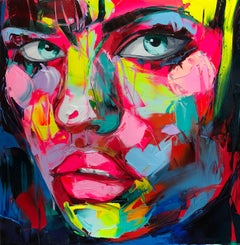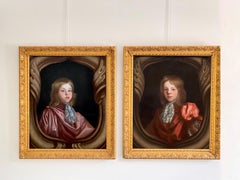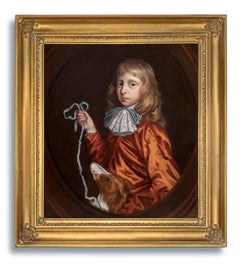(Circle of) Mary Beale Art
to
1
Overall Width
to
Overall Height
to
1
1
1
1
1
1
1
1
1
1
1
9,479
2,688
1,375
1,361
1
Artist: (Circle of) Mary Beale
Portrait of a Gentleman, 17th Century English Oil on Canvas
By (Circle of) Mary Beale
Located in London, GB
Circle of Mary Beale
1633 - 1699
Portrait of a Gentleman
Oil on canvas
Image size: 30 x 25 inches
Contemporary gilt frame
Mary Beale was the daughter of a Suffolk clergyman.She married Charles Beale...
Category
17th Century (Circle of) Mary Beale Art
Materials
Canvas, Oil
Related Items
10-11-9 - 21st Century, Contemporary, Nude Painting, Oil on Canvas
By Montse Valdés
Located in Barcelona, Catalonia
“I paint the human figure and explore further till I reach the Beauty of Being, the Soul.. the part of Human Being where everything is in total Serenity, Goodness and Harmony, where ...
Category
21st Century and Contemporary Contemporary (Circle of) Mary Beale Art
Materials
Canvas, Oil
$17,586 Sale Price
20% Off
H 51.19 in W 76.78 in
Caprice - 21st Century, Contemporary, Figurative, Oil Painting, Portrait, Pop
By Françoise Nielly
Located in Barcelona, Catalonia
Françoise Nielly has explored the different facets of image all her life, through painting, photography, roughs, illustrations and virtual computer generated animated graphics. It is...
Category
21st Century and Contemporary Contemporary (Circle of) Mary Beale Art
Materials
Canvas, Oil
$11,651 Sale Price
20% Off
H 31.5 in W 31.5 in
Early 20th century Art Deco Male nude oil painting of Narcissus
By George Frederick Hinchcliff
Located in Harkstead, GB
An incredibly striking study of the male form with the figure set against a colourful background with stylised organic forms. Attractively framed, the painting is ready to be hung an...
Category
1930s Modern (Circle of) Mary Beale Art
Materials
Oil, Canvas
$1,555 Sale Price
29% Off
H 16 in W 20 in D 2 in
Venice Landscape Italian Oil on Canvas Painting in Gilt Wood Frame, Belle Epoque
Located in Firenze, IT
This delightful turn of the century (early 20th century) oil on canvas painting represents an Italian landscape with one of the most famous squares in the world: Piazza San Marco in ...
Category
Early 20th Century Impressionist (Circle of) Mary Beale Art
Materials
Canvas, Oil
Venice Landscape Italian Oil on Canvas Painting in Gilt Wood Frame, Belle Epoque, Early 20th Century
$8,460 Sale Price
25% Off
H 51.19 in W 33.47 in D 1.19 in
“Enfant A La Collarette” The Child in the Collar.
By René Genis
Located in Berlin, MD
Rene Genis (French 1922-2004) “Enfant A La Collarette” The Child in the Collart. Portrait of a disturbing young man with a rather defiant, petulant look in his expression. Dark eye...
Category
Mid-20th Century (Circle of) Mary Beale Art
Materials
Canvas, Oil, Laid Paper
$2,025 Sale Price
48% Off
H 24 in W 16 in D 1 in
"Femme et Homards" (Woman with Lobsters), 1948 -André Minaux (French, 1923-1986)
By Andre Minaux
Located in Berlin, MD
Behold a mid-century marvel by André Minaux, a titan of the French School whose stylized Social Realist visions continue to captivate the art world. Painted in 1948, “Femme et Homard...
Category
Mid-20th Century French School (Circle of) Mary Beale Art
Materials
Cotton Canvas, Oil
$5,135
H 62.25 in W 43.5 in D 3 in
Grim - 21st Century, oil painting, canvas, portrait, social commentary
Located in Barcelona, Catalonia
Renowned for his mastery in design and sculpture, Tena embarked on a profound personal journey in 2023, which rekindled his passion for painting after a 30-year hiatus. His return to...
Category
21st Century and Contemporary Contemporary (Circle of) Mary Beale Art
Materials
Canvas, Oil, Acrylic
$8,602
H 59.06 in W 47.25 in D 1.58 in
11-4-11 - 21st Century, Contemporary, Portrait Painting, Oil on Canvas
By Montse Valdés
Located in Barcelona, Catalonia
“I paint the human figure and explore further till I reach the Beauty of Being, the Soul.. the part of Human Being where everything is in total Serenity, Goodness and Harmony, where ...
Category
21st Century and Contemporary Contemporary (Circle of) Mary Beale Art
Materials
Canvas, Oil
$7,759 Sale Price
20% Off
H 45.67 in W 25.6 in
6-8-10 - 21st Century, Contemporary, Nude Painting, Oil on Canvas
By Montse Valdés
Located in Barcelona, Catalonia
“I paint the human figure and explore further till I reach the Beauty of Being, the Soul.. the part of Human Being where everything is in total Serenity, Goodness and Harmony, where ...
Category
21st Century and Contemporary Contemporary (Circle of) Mary Beale Art
Materials
Canvas, Oil
$7,316
H 28.75 in W 36.23 in
Samu - 21st Century, oil painting, canvas, portrait, social commentary
Located in Barcelona, Catalonia
Renowned for his mastery in design and sculpture, Tena embarked on a profound personal journey in 2023, which rekindled his passion for painting after a 30-year hiatus. His return to...
Category
21st Century and Contemporary Contemporary (Circle of) Mary Beale Art
Materials
Canvas, Oil, Acrylic
$8,615
H 59.06 in W 47.25 in D 1.58 in
Bowie - 21st Century, oil painting, canvas, portrait, social commentary
Located in Barcelona, Catalonia
Renowned for his mastery in design and sculpture, Tena embarked on a profound personal journey in 2023, which rekindled his passion for painting after a 30-year hiatus. His return to...
Category
21st Century and Contemporary Contemporary (Circle of) Mary Beale Art
Materials
Canvas, Oil, Acrylic
$8,615
H 59.06 in W 47.25 in D 1.58 in
Anthony - 21st Century, oil painting, canvas, portrait, social commentary
Located in Barcelona, Catalonia
Renowned for his mastery in design and sculpture, Tena embarked on a profound personal journey in 2023, which rekindled his passion for painting after a 30-year hiatus. His return to...
Category
21st Century and Contemporary Contemporary (Circle of) Mary Beale Art
Materials
Canvas, Oil, Acrylic
$8,602
H 59.06 in W 47.25 in D 1.58 in
Previously Available Items
Pair of 17th century British Portraits of the brothers Baronet Stapleton English
By (Circle of) Mary Beale
Located in Aartselaar, BE
Pair of 17th century British Portraits, James and William Stapleton, 2nd and 3rd Baronet Stapleton of the Leeward Islands, at the ages of 11 and 8, ca ...
Category
17th Century Old Masters (Circle of) Mary Beale Art
Materials
Canvas, Oil
Portrait of a Young Gentleman and Pet Dog c.1680, Antique oil on Canvas Painting
By (Circle of) Mary Beale
Located in London, GB
The portrait genre was valued particularly highly in English society. Neither landscapes nor allegorical pictures were ever priced so highly at exhibitions and in the trade as depictions of people, from the highest aristocracy to scholars, writers, poets and statesmen. This charming portrait, presented by Titan Fine Art, of a fashionable young gentleman and his faithful pet is an excellent example of 17th century child portraiture in England. There is a remarkable beauty and sensitivity to the portrait. The face, particularly well rendered, has captured the character of this young man – both charming and at the same time mischievous.
Only the playful attention of a small dog suggests anything less than patrician dignity. Symbolism was important in portraiture and it provided a pointed and aspirational narrative that would not have been lost on contemporary viewers. For example, the presence of the dog, which was likely the boy’s pet, is at once a charming pictorial device and also a clear allusion to fidelity, trust and loyalty.
The hairstyle and the attire, notably the type of cravat with the blue ribbon, help to date this portrait to between 1670 to 1685. Until the late eighteenth century children were dressed as adults - boys were dressed like men in breeches, vests, and coats between four and seven years of age. The expensive lace is an indication to his family’s wealth.
Held in a good quality and condition antique gilded frame.
Born in Suffolk, Mary Beale, nee Cradock (1633-1699) was employed by many of the most distinguished persons of her time including nobility, landed gentry, and clergymen. Technically accomplished, her paintings are noteworthy for their honest and sympathetic portrayal. In 1651 she married Charles Beale...
Category
17th Century Old Masters (Circle of) Mary Beale Art
Materials
Canvas, Oil
H 35.44 in W 32.29 in D 3.15 in
Portrait of a Young Lady in a Russet Dress with Blue Wrap c.1680’s; Mary Beale
By (Circle of) Mary Beale
Located in London, GB
Portrait of a Young Lady in a Russet Dress with Blue Wrap c.1680’s
Circle or Studio of Mary Beale (1632-1699)
This exquisite portrait is a charming example of English portraiture from the 1680’s. It depicts a young woman at the tender age of perhaps fifteen; she would have been deemed ready for marriage. It is remarkable for its sensitivity, its beauty, and for its portrayal of the sitter’s amiable and friendly character. An elaborate sculpted cartouche used in portraits, as seen here, was employed by many artists in England at the time, but most frequently by Sir Peter Lely and Mary Beale, the most important woman artist to work in England in the second half of the seventeenth century.
The portrait genre was valued particularly highly in English society. Neither landscapes nor allegorical pictures were ever priced so highly at exhibitions and in the trade as depictions of people, from the highest aristocracy to scholars, writers, poets and statesmen. Traditionally the portrait has been attributed to Mary Beale; this attribution is certainly possible.
A charming example of English portraiture during the reign of Charles II. Contained in a fine quality gilded antique frame.
Born in Suffolk, Mary Beale, nee Cradock (1633-1699) was employed by many of the most distinguished persons of her time including nobility, landed gentry, and clergymen. Technically accomplished, her paintings are noteworthy for their honest and sympathetic portrayal. In 1651 she married Charles Beale, who shared her interest in art, and thus the Beale studio was a partnership between husband and wife. While Mary painted, Charles provided practical support. He primed canvases, procured art supplies from merchants, manufactured expensive, high-end pigments such as red lake and ultramarine (some for sale to other painters), and kept the books. He also left detailed notebooks about his wife’s daily activities; such as her commissioned portraits as well as the experimental studies. For the latter, he identifies the sitters and, in most cases, their poses and tracks the progress of each work from one sitting to the next, paying particular attention if a novel technique had been used. The Beale's purpose in carrying out the studies, as well as to develop skills, was to test out, various painting methods. Together they sought to improve the studio's efficiency, through perfecting procedures that would produce good results at a lower cost. These accounts of the daily activities are an incredibly valuable insight into the working practices of her studio. In fact, we know more of her technique and working practice than that of many of her contemporaries, including Sir Peter Lely.
By the late 1650s, Beale had developed a formidable reputation and befriended Sir Peter Lely, the leading artist of the Restoration and court painter to Charles II, King of England. She observed Lely in his studio—a rare privilege—and copied many of his portraits, modelling her technique after his. Lely would visit the Beale home occasionally to observe Mary paint and praise her work and Lely loaned Beale some of his old master paintings to copy from.
During her childhood in Suffolk Mary's father was friendly with contemporary British artists such as Sir Nathaniel Bacon, Robert Walker, and Sir Peter Lely, leading to both Robert Walker and Peter Lely being "the most likely drawing masters to the young Mary". Even though Beale occasionally adapted some of Lely’s poses it is not known for certain with whom she studied; Lely encouraged her in her efforts but there is no evidence that he actually instructed her. However, her father was an amateur artist and seems the most likely candidate to have shown her how to draw and paint.
She was exceedingly industrious and experimented with many new materials and techniques. She often employed the use of an elaborate stone cartouche...
Category
17th Century Old Masters (Circle of) Mary Beale Art
Materials
Oil, Canvas
H 37.21 in W 32.29 in D 2.37 in
(circle Of) Mary Beale art for sale on 1stDibs.
Find a wide variety of authentic (Circle of) Mary Beale art available for sale on 1stDibs. You can also browse by medium to find art by (Circle of) Mary Beale in canvas, fabric, oil paint and more. Much of the original work by this artist or collective was created during the 18th century and earlier and is mostly associated with the Old Masters style. Not every interior allows for large (Circle of) Mary Beale art, so small editions measuring 25 inches across are available. Customers who are interested in this artist might also find the work of Sir Godfrey Kneller, Studio of Sir Peter Lely, and George Wright . (Circle of) Mary Beale art prices can differ depending upon medium, time period and other attributes. On 1stDibs, the price for these items starts at $6,135 and tops out at $7,744, while the average work can sell for $6,940.


